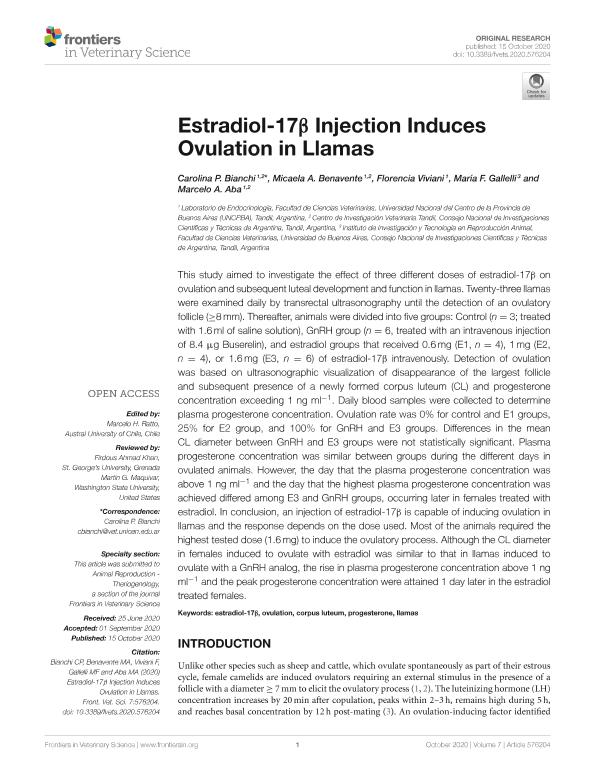Mostrar el registro sencillo del ítem
dc.contributor.author
Bianchi, Carolina Paula

dc.contributor.author
Benavente, Micaela Andrea

dc.contributor.author
Viviani, Florencia

dc.contributor.author
Gallelli, Maria Florencia

dc.contributor.author
Aba, Marcelo Alfredo

dc.date.available
2021-01-04T13:24:16Z
dc.date.issued
2020-10
dc.identifier.citation
Bianchi, Carolina Paula; Benavente, Micaela Andrea; Viviani, Florencia; Gallelli, Maria Florencia; Aba, Marcelo Alfredo; Estradiol-17β Injection Induces Ovulation in Llamas; Frontiers Media S.A.; Frontiers in Veterinary Science; 7; 10-2020; 1-6
dc.identifier.issn
22971769
dc.identifier.uri
http://hdl.handle.net/11336/121367
dc.description.abstract
This study aimed to investigate the effect of three different doses of estradiol-17b onovulation and subsequent luteal development and function in llamas. Twenty-three llamaswere examined daily by transrectal ultrasonography until the detection of an ovulatoryfollicle (≥8mm). Thereafter, animals were divided into five groups: Control (n = 3; treatedwith 1.6ml of saline solution), GnRH group (n = 6, treated with an intravenous injectionof 8.4 μg Buserelin), and estradiol groups that received 0.6mg (E1, n = 4), 1mg (E2,n = 4), or 1.6mg (E3, n = 6) of estradiol-17b intravenously. Detection of ovulationwas based on ultrasonographic visualization of disappearance of the largest follicleand subsequent presence of a newly formed corpus luteum (CL) and progesteroneconcentration exceeding 1 ng ml−1. Daily blood samples were collected to determineplasma progesterone concentration. Ovulation rate was 0% for control and E1 groups,25% for E2 group, and 100% for GnRH and E3 groups. Differences in the meanCL diameter between GnRH and E3 groups were not statistically significant. Plasmaprogesterone concentration was similar between groups during the different days inovulated animals. However, the day that the plasma progesterone concentration wasabove 1 ng ml−1 and the day that the highest plasma progesterone concentration wasachieved differed among E3 and GnRH groups, occurring later in females treated withestradiol. In conclusion, an injection of estradiol-17b is capable of inducing ovulation inllamas and the response depends on the dose used. Most of the animals required thehighest tested dose (1.6mg) to induce the ovulatory process. Although the CL diameterin females induced to ovulate with estradiol was similar to that in llamas induced toovulate with a GnRH analog, the rise in plasma progesterone concentration above 1 ngml−1 and the peak progesterone concentration were attained 1 day later in the estradioltreated females.
dc.format
application/pdf
dc.language.iso
eng
dc.publisher
Frontiers Media S.A.

dc.rights
info:eu-repo/semantics/openAccess
dc.rights.uri
https://creativecommons.org/licenses/by/2.5/ar/
dc.subject
CORPUS LUTEUM
dc.subject
ESTRADIOL-17Β
dc.subject
LLAMAS
dc.subject
OVULATION
dc.subject
PROGESTERONE
dc.subject.classification
Ciencias Veterinarias

dc.subject.classification
Ciencias Veterinarias

dc.subject.classification
CIENCIAS AGRÍCOLAS

dc.title
Estradiol-17β Injection Induces Ovulation in Llamas
dc.type
info:eu-repo/semantics/article
dc.type
info:ar-repo/semantics/artículo
dc.type
info:eu-repo/semantics/publishedVersion
dc.date.updated
2020-12-22T15:44:20Z
dc.identifier.eissn
2297-1769
dc.journal.volume
7
dc.journal.pagination
1-6
dc.journal.pais
Suiza

dc.description.fil
Fil: Bianchi, Carolina Paula. Consejo Nacional de Investigaciones Científicas y Técnicas. Centro Científico Tecnológico Conicet - Tandil. Centro de Investigación Veterinaria de Tandil. Universidad Nacional del Centro de la Provincia de Buenos Aires. Centro de Investigación Veterinaria de Tandil. Provincia de Buenos Aires. Gobernación. Comision de Investigaciones Científicas. Centro de Investigación Veterinaria de Tandil; Argentina
dc.description.fil
Fil: Benavente, Micaela Andrea. Consejo Nacional de Investigaciones Científicas y Técnicas. Centro Científico Tecnológico Conicet - Tandil. Centro de Investigación Veterinaria de Tandil. Universidad Nacional del Centro de la Provincia de Buenos Aires. Centro de Investigación Veterinaria de Tandil. Provincia de Buenos Aires. Gobernación. Comision de Investigaciones Científicas. Centro de Investigación Veterinaria de Tandil; Argentina
dc.description.fil
Fil: Viviani, Florencia. Universidad Nacional del Centro de la Provincia de Buenos Aires. Facultad de Ciencias Veterinarias; Argentina
dc.description.fil
Fil: Gallelli, Maria Florencia. Universidad de Buenos Aires. Facultad de Ciencias Veterinarias; Argentina. Consejo Nacional de Investigaciones Científicas y Técnicas; Argentina
dc.description.fil
Fil: Aba, Marcelo Alfredo. Consejo Nacional de Investigaciones Científicas y Técnicas. Centro Científico Tecnológico Conicet - Tandil. Centro de Investigación Veterinaria de Tandil. Universidad Nacional del Centro de la Provincia de Buenos Aires. Centro de Investigación Veterinaria de Tandil. Provincia de Buenos Aires. Gobernación. Comision de Investigaciones Científicas. Centro de Investigación Veterinaria de Tandil; Argentina
dc.journal.title
Frontiers in Veterinary Science
dc.relation.alternativeid
info:eu-repo/semantics/altIdentifier/url/https://www.frontiersin.org/article/10.3389/fvets.2020.576204/full
dc.relation.alternativeid
info:eu-repo/semantics/altIdentifier/doi/http://dx.doi.org/10.3389/fvets.2020.576204
Archivos asociados
